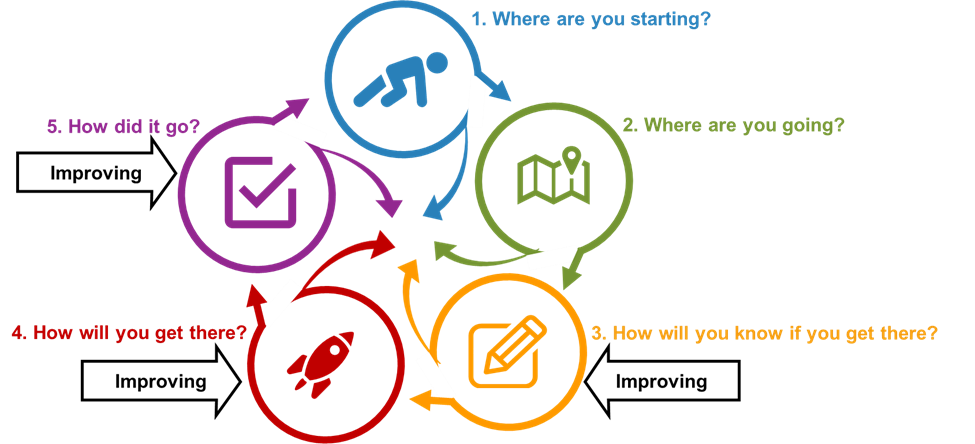
C. Teaching Practices
C12. Improving the Course & Your Teaching
Improving the Course & Your Teaching
The last step in the IDI process is evaluation of how it all went. This is detailed with worksheets in Unit W, Chapter W5.
Self-Evaluation
In the beginning, you listed what you wanted your students to be able to do by the end of the course. Once you get to the end, you can compare these outcomes to where the students actually are (you can review the grade average). In addition, you can review the course session reviews (reviews you wrote at the end of each session), and any other self-evaluations.
Student Evaluation of the Course & Teaching
Receiving feedback is a very powerful way to improve your teaching, but only if you change based on the feedback. You can receive feedback during the course or at the end.
Specifically, feedback can be used to:
- identify what topic(s) you need to focus on in the next class session.
- make meaningful changes quickly and efficiently.
- consider different approaches to providing information.
- reconsider future activities within future classes or courses.
- promote student engagement.
Methods to Receive Feedback
- Ask a colleague or TLC staff member to observe your class and provide feedback
- Use some of the Classroom Assessment Techniques (CATs) (see Angelo & Cross, 1993, and refer to spreadsheet https://docs.google.com/spreadsheets/d/1NAIxhpdmS0MVONw6Zzb9kutBdBouGhM8w4CqFLFlTDI/edit#gid=0)
- Ask students for process-related feedback during a class session (using clickers, in-class chat/backchannels, etc.)
- Request a small group instructional diagnostic (SGID) review (many TLCs offer these) (For more info, see Small Group Instructional Diagnostic (SGID), n.d.)
- Request Early Term Feedback (ETF) (many TLCs offer these) (For more info, see Early Term Feedback (ETF), n.d.)
- Request a Student Assessment of their Learning Gains (SALG) evaluations (many TLCs offer these) (see SALG – Student Assessment of Their Learning Gains, n.d.)
- Review end-of-course feedback and surveys
- Use the PORTAAL rubric. “This tool both clarifies the research-supported elements of best practices for instructor implementation of active learning in the classroom setting and measures instructors’ alignment with these practices” (Eddy et al., 2015, art. abstract).
Reacting to Feedback.
When receiving feedback, it is natural to focus on the few bad reviews. Put these in focus by thinking how many students had similar feedback for you.
If you are concerned, consider asking your TLC to help you review the feedback and determine actions needed.
If you receive feedback from students:
- thank your students
- if possible, tell them what changes you will make (either in the next course offering or in future sessions of this course)
- make notes for yourself on what you might change, when, and how
IDI & Improving the Course & Your Teaching

The following describe actions you can take to use concepts from Improving the Course & Your Teaching in the IDI model:
Step 3. How Will You Know If You Get There?
3.2 Develop Instruments to Evaluate the Course
- Review the Classroom Assessment Techniques (CATs) in the “Techniques for Assessing Course-Related Knowledge & Skills” category (see Angelo & Cross, 1993) to identify if you will use some of these.
- Determine what tools you will use to receive feedback on the course and your teaching.
- If you decide to use CATs (such as ‘Muddiest Point’ types of activities), SGID, ETF, SALG, or colleague observations, schedule these with the required people.
- Develop any questionnaires (including CATs) and schedule them.
- Schedule when you will provide students with feedback about any evaluations.
- Add course & teaching assessments to students’ schedule in syllabus.
- Add course & teaching assessments to the instructor’s schedule.
Step 4. How Will You Get There?
4.1 Develop & Teach Course
- Check the instructor’s course schedule to determine if any course and teaching feedback is scheduled.
- Administer any course improvement questionnaires you have scheduled.
- Thank your students for the feedback.
- Provide students with feedback about changes you will try to make.
Step 5. How Did It Go?
5.1 Evaluate Course Success
- Review all notes on all the class outlines to note what went well, what could have been improved, and what you need to change.
- Review student course evaluations.
- Compare student grades to learning outcomes. Identify potential improvements by asking yourself:
- What could I have done differently to support students to reach the outcomes?
- What outcomes and objectives need to be revised or eliminated?
- What outcomes and objectives need to be added?
- Why did the unsuccessful students not accomplish the outcomes?
- If students in specific demographic groups had issues, what can I do to improve learning for them?
- Create concrete goals for yourself to improve your next offering of this course.
- Create concrete goals for yourself to improve other courses you will teach.
- For each goal, create SMART objectives and a schedule for implementation.
References
Angelo, T., & Cross, K. P. (1993). Classroom Assessment Techniques: A Handbook for College Teachers (2nd ed.). Jossey-Bass.
Early Term Feedback (ETF). (n.d.). University of Cincinnati. Retrieved July 21, 2020, from https://www.uc.edu:8443https://uc.edu/cetl/ourwork/pedagogy/etf.
Eddy, S. L., Converse, M., & Wenderoth, M. P. (2015). PORTAAL: A Classroom Observation Tool Assessing Evidence-Based Teaching Practices for Active Learning in Large Science, Technology, Engineering, and Mathematics Classes. CBE—Life Sciences Education, 14(2), ar23. https://doi.org/10.1187/cbe.14-06-0095.
Reid, P. (n.d.). CAT Cross-ref to Goals. Google Docs. Retrieved July 7, 2022, from https://docs.google.com/spreadsheets/d/1AkMMP75OdeOL4PNjTYvuKaDBTRn2wqxDdBAQtjAuCCo/edit?usp=sharing&usp=embed_facebook.
SALG – Student Assessment of their Learning Gains. (n.d.). Retrieved March 22, 2021, from https://salgsite.net/.
Small Group Instructional Diagnostic (SGID). (n.d.). Teaching & Learning Center (TLC) – UW Bothell. Retrieved July 21, 2020, from https://www.uwb.edu/tlc/sgid.
